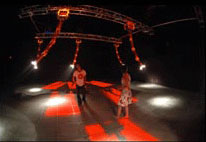
Back to archives | Back to FOFA Gallery

Photo: Bill Vorn
|
BILL VORN: RED LIGHT
RED LIGHT: A Reactive Robotic Installation by BILL VORN
January 11 – February 9
Bill Vorn’s cybernetic, feral creatures inhabit a highly theatrical space that evokes the sensation of imminent danger. The moving, twitching machines instantly sense any human intrusion into their environment, emitting loud metallic sounds and flashing lights, and further reacting to human presence in unpredictable, menacing ways. By confronting such complex robotic creatures, the visitor learns to anticipate their erratic behavior, to negotiate a space of coexistence, and perhaps even to empathize with them. Since 1992, Vorn has explored the “aesthetics of artificial behavior” in various robotic art installations. RED LIGHT is his most recent reactive robotic environment.
The red light flooding the gallery space already alerts one to beware. Stepping into the RED LIGHT area, one finds oneself in the midst of eight strange, gesticulating bodies, consisting of long pneumatic and mechanical tubes with sensors. Six of these tentacle-like creatures are hanging from the ceiling, seemingly watching two others convulse on the ground. Immediately, they sense the presence of a visitor. Their tubular muscles contract and conflate, generating a wild play of strobe lights and hissing sounds. They move towards the visitor in a seemingly random, chaotic fashion. But even while they are drawn to the presence of the human intruder, they appear to be secretly communicating amongst themselves – or perhaps conspiring. Once one has entered their strange RED LIGHT habitat, one can no longer remain a passive, detached spectator. Whether choosing to interact with the robotic creatures by touching or moving around them, or whether remaining immobile, one inevitably finds oneself engaging with these animate machines, and by so doing, one becomes an integral part of the RED LIGHT spectacle.
Setting up a space where such human-machine interactions are played out is the goal of the artist, Bill Vorn. While wishing to explore the techniques and technologies relating to “parallel mechanics” and pneumatics, his primary aim is to create a space for human and machine behavioral interrelationships. This is a space where the human qualities of machines and the machine-like character of human beings “are intermixed” and where any behavioral distinctions between them “become blurred.”
Text by Ernestine Daubner, Department of Art History, Concordia University
|
|


